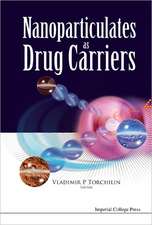Molecular Communications and Nanonetworks: From Nature To Practical Systems
Autor Barış Atakanen Limba Engleză Paperback – oct 2016
| Toate formatele și edițiile | Preț | Express |
|---|---|---|
| Paperback (1) | 635.65 lei 6-8 săpt. | |
| Springer – oct 2016 | 635.65 lei 6-8 săpt. | |
| Hardback (1) | 644.18 lei 6-8 săpt. | |
| Springer – 27 apr 2014 | 644.18 lei 6-8 săpt. |
Preț: 635.65 lei
Preț vechi: 747.82 lei
-15% Nou
Puncte Express: 953
Preț estimativ în valută:
121.65€ • 125.50$ • 102.96£
121.65€ • 125.50$ • 102.96£
Carte tipărită la comandă
Livrare economică 04-18 martie
Preluare comenzi: 021 569.72.76
Specificații
ISBN-13: 9781493948208
ISBN-10: 1493948202
Pagini: 184
Ilustrații: XIII, 184 p. 74 illus., 3 illus. in color.
Dimensiuni: 155 x 235 x 11 mm
Greutate: 0.29 kg
Ediția:Softcover reprint of the original 1st ed. 2014
Editura: Springer
Colecția Springer
Locul publicării:New York, NY, United States
ISBN-10: 1493948202
Pagini: 184
Ilustrații: XIII, 184 p. 74 illus., 3 illus. in color.
Dimensiuni: 155 x 235 x 11 mm
Greutate: 0.29 kg
Ediția:Softcover reprint of the original 1st ed. 2014
Editura: Springer
Colecția Springer
Locul publicării:New York, NY, United States
Cuprins
Molecular Communication Among Nanomachines.- Passive Molecular Communication Through Absorbers.- Passive Molecular Communication Through Ligand-Receptor Binding.- Active Molecular Communication.
Notă biografică
Baris Atakan, PhD is currently at Izmir Institute of Technology.
Textul de pe ultima copertă
In this book, the concepts of molecular communications and nanonetworks are introduced. Throughout the book, the existing molecular communication paradigms are categorized into two main groups. The first group includes the Passive Molecular Communication (PMC) paradigms in which molecules freely diffuse to transfer information from a transmitter to a receiver. The second group includes the Active Molecular Communication (AMC) paradigms in which molecules are carried or guided by some mediators such as molecular motors, gap junction channels and bacteria. In the book, after briefly discussing why molecular communication is needed for the sophisticated nano and biotechnology applications, the existing molecular communication systems are first presented. Then, the principles of diffusion phenomena and molecular reception with absorbers and the ligand-receptor binding mechanism are introduced. Based on these principles, the communication theories and techniques are given for the PMC. Then, the physical dynamics of molecular motors, calcium (Ca2+) signaling (with gap junction channels), cell-to-cell adhesion, motile behavior of bacteria are reviewed and based on these dynamics the AMC paradigms are discussed from the viewpoint of the communication theory.
Caracteristici
Introduces the concept of molecular communications and nanonetworks by reviewing the diverse sets of literature from the different research domains such as biophysics, biochemistry, synthetic biology and communication. Highlights the communication theoretical viewpoints and different modeling approaches which are used to understand the nature-made molecular communication phenomena Examines the roles of molecular communications in many promising applications such as cancer cell detection and elimination with the communicating engineered bacteria and the signal processing applications with a colony of communicating bacteria Includes supplementary material: sn.pub/extras
















